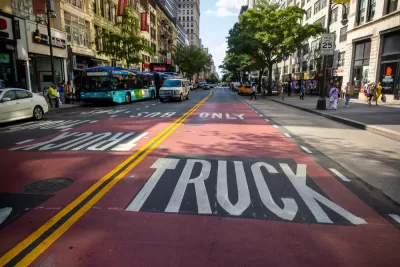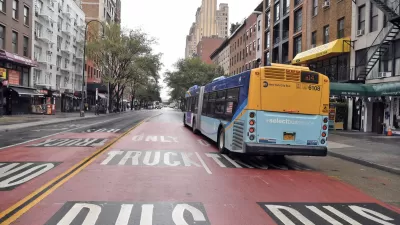An ambitious program to add 20 miles of bus lanes and protected bus ways in the city of New York has been diminished by political opposition in parts of the city.

The New York City Department of Transportation has bowed to Staten Island car owners who objected to a bus lane project, reports Gersh Kuntzman.
The scaled back proposal originally called for dedicated bus lanes in both directions on a 3.3-mile stretch of Hylan Boulevard, according to Kuntzman. "Instead of bus lanes on both side of Hylan between Lincoln and Nelson avenues, the plan now calls for a 1.4-mile bus lane on the south side of Hylan, between Lincoln and Guyon avenues."
Kuntzman notes that the scaled back version of the Staten Island bus lane project is "the second high-profile pullback from a supposed commitment to help long-suffering transit riders in as many weeks." The first: a car-free .3-mile stretch in Flushing that has been suspended indefinitely "after Council Member Peter Koo claimed, in racially supercharged language, that the busway would hurt local businesses, explains Kuntzman. Kuntzman makes sure to point out that the idea that bus lanes hurt local businesses is a myth, "dispelled by DOT’s own statistics."
Councilmembers Steven Matteo and Joe Borelli of Staten Island were responsible for the revised plan for the Hylan Boulevard in Staten Island, according to Kuntzman, who cites an article by the Staten Island Advance for the original news about this particular bus project's demise.
In June, Mayor Bill de Blasio announced plans to roll out an ambitious program of new bus lanes and protected busways around the city to assist transit riders during and after the pandemic, but as reported recently, much of that promise has stalled or, as in the case of these two projects, been scaled back or suspended entirely.
FULL STORY: ANOTHER TRANSIT DEBACLE: DOT Guts Its Own Bus Lane Project

Study: Maui’s Plan to Convert Vacation Rentals to Long-Term Housing Could Cause Nearly $1 Billion Economic Loss
The plan would reduce visitor accommodation by 25,% resulting in 1,900 jobs lost.

Alabama: Trump Terminates Settlements for Black Communities Harmed By Raw Sewage
Trump deemed the landmark civil rights agreement “illegal DEI and environmental justice policy.”

Why Should We Subsidize Public Transportation?
Many public transit agencies face financial stress due to rising costs, declining fare revenue, and declining subsidies. Transit advocates must provide a strong business case for increasing public transit funding.

Paris Bike Boom Leads to Steep Drop in Air Pollution
The French city’s air quality has improved dramatically in the past 20 years, coinciding with a growth in cycling.

Why Housing Costs More to Build in California Than in Texas
Hard costs like labor and materials combined with ‘soft’ costs such as permitting make building in the San Francisco Bay Area almost three times as costly as in Texas cities.

San Diego County Sees a Rise in Urban Coyotes
San Diego County experiences a rise in urban coyotes, as sightings become prevalent throughout its urban neighbourhoods and surrounding areas.
Urban Design for Planners 1: Software Tools
This six-course series explores essential urban design concepts using open source software and equips planners with the tools they need to participate fully in the urban design process.
Planning for Universal Design
Learn the tools for implementing Universal Design in planning regulations.
Smith Gee Studio
Alamo Area Metropolitan Planning Organization
City of Santa Clarita
Institute for Housing and Urban Development Studies (IHS)
City of Grandview
Harvard GSD Executive Education
Toledo-Lucas County Plan Commissions
Salt Lake City
NYU Wagner Graduate School of Public Service




























